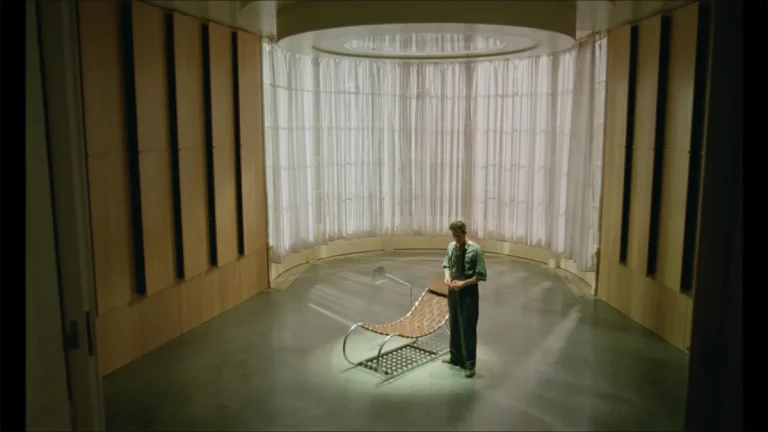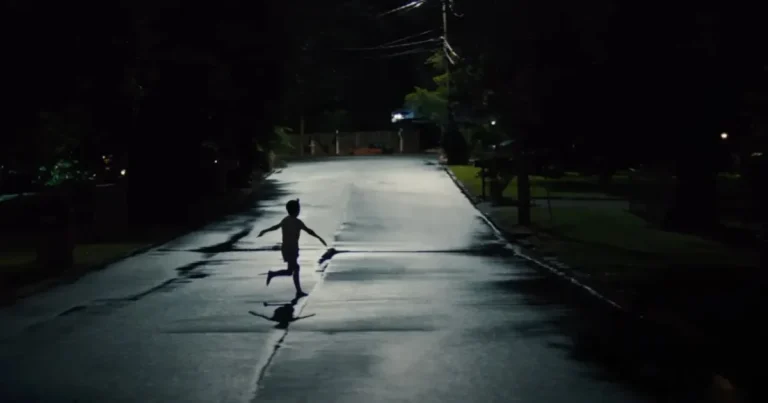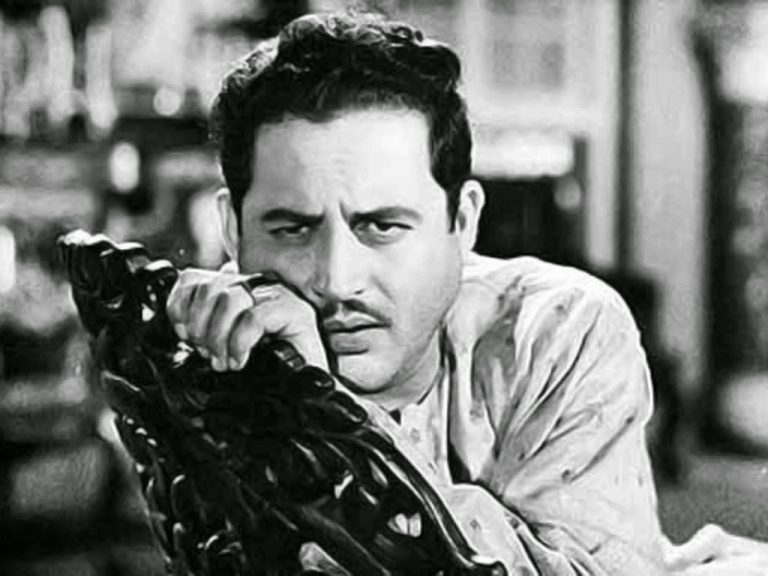Michael Shanks’ “Together” (2025) stands out as one of the year’s most compelling horror films—not just for its immersive visual style, but for the psychological depth beneath it. In his directorial debut, Shanks deftly explores the unraveling relationship of Millie (Alison Brie), a high school teacher, and Tim (Dave Franco), a struggling musician. As communication breaks down and intimacy fades, Millie feels suffocated by the lack of emotional support, while Tim wrestles with insecurity and financial dependence. Hoping for a fresh start, the couple relocates to a quiet countryside home after Millie accepts a new teaching job—unaware that their attempts at renewal will only draw them deeper into disintegration.
The isolated house lies deep within a dense forest. Hoping to repair their fading relationship, Millie and Tim attempt a fresh start—but their lives shift dramatically after an unforeseen incident. While exploring the woods, they lose their way and stumble upon a mysterious cave, where they are forced to spend the night due to a sudden storm. After returning, they begin to sense an eerie change within themselves: an overpowering, almost unnatural attraction that blurs the boundaries between their bodies. What unfolds is a grotesque and haunting tale of entanglement. I will refrain from detailing the plot further, assuming readers are familiar with the film. However, the following sections will contain necessary spoilers for a deeper analysis.
“Together” stands out in several ways. It transcends the bounds of conventional body horror, using the genre’s familiar tropes to delve into more unsettling territories of co-dependency, emotional detachment, and depersonalization, without ever losing its grip on the visceral essence that defines horror. Hence, it becomes much more than just another regular horror story. Secondly, and perhaps more importantly, it remains significant as an intricate chronicle of a disintegrating relationship.
What makes this film more thought-provoking is the philosophical nuance it carries. It is not your regular horror movie that you watch for the sake of entertainment and then immediately discard from your memory. It lingers in your mind long after the credits have rolled and leaves a lasting impact. All the readers who have already watched the film are well aware of the fact that there is an overarching presence of a new-age fusion cult in the film. The film introduces a group of obsessed individuals who believe that humans can attain perfection by physically fusing with each other.
Jamie, an integral character in the film and a prominent member of the aforementioned cult, speaks about a myth from ancient Greece while manipulating Milli in a pivotal sequence. The basic foundation of the cult is dependent on the idea suggested in this mythical tale that Jamie narrates. The primary objective of the article is to trace the root of this myth. I will begin by illustrating what this myth conveys, and then move on to trace its literary legacy, including the vast forum for discourse it generated.
The mythical story, narrated in the film in a highly summarized manner, was originally proposed by the famous ancient Greek playwright and satirist, Aristophanes, in one of his most controversial speeches. Let us proceed with our detailed discussion of the speech.
Understanding The Speech by Aristophanes: Expression, Reception, and Criticism
The speech attributed to Aristophanes appears in Plato’s Symposium, a philosophical dialogue structured around a banquet where several Athenian intellectuals offer speeches in praise of Eros (love). The dialogue presents six principal speakers—Phaedrus, Pausanias, Eryximachus, Aristophanes, Agathon, and Socrates—each articulating a distinctive understanding of love in their own style, followed by a final, more personal address by Alcibiades. Among these, Aristophanes’ mythic and imaginative account has remained one of the most memorable and frequently discussed.
Also Read: Together (2025) ‘Fantasia’ Movie Review: Pulling Apart The Horrors of Incompatibility
In his speech, Aristophanes describes how humans were originally spherical beings, possessing four arms, four legs, two faces oriented in opposite directions, and two sets of genitals. These primordial creatures were powerful and self-sufficient, moving swiftly by cartwheeled on their eight limbs. Their strength and completeness made them prideful, provoking Zeus’s concern that they might challenge the gods. To weaken them and preserve divine authority, he split each in two, thus creating the human longing for one’s lost half.
According to Aristophanes, there were three kinds of original beings: male, female, and androgynous. Each type reflected its cosmic lineage—the male descended from the sun, the female from the earth, and the androgynous from the moon, which partakes of both. This myth poetically explains the diversity of human desire and the deep-seated drive to seek completion through union with another.
These humans were complete, self-reliant, and sufficient, but their extraordinary abilities soon made them pompous and vigorous. They attacked the gods and caused havoc in the celestial realm. When they finally attempted to overthrow the gods by storming Mount Olympus, Zeus, the king of the gods in Hellenistic polytheism, decided to cut the humans in half in order to punish their insolence. The humans now remained with two legs, two arms, and a single head identical to the modern anatomical design; their heads were rotated by Apollo to make them face the gash, and the skin was stretched to cover the incision forming the navel.
Humans became humbled as their power decreased. Zeus pitied their state of vulnerability and moved their genitals to the front, which enabled them to engage in sexual intercourse and reproduction, ensuring continuity of the human race. Hence, this tragic downfall of humanity was caused by its uncontrollable arrogance, audacity, and hubris (excessive pride). Aristophanes exclaimed that, from then on, those incomplete humans have been roaming around the earth in search of their other halves. This describes why humans are born with an inherent longing and urge to unite with their estranged halves and become whole. This is what Aristophanes denoted as love: this restlessness, this craving for completeness.
When humans meet their appropriate partners, they feel an ethereal sense of reunion. Aristophanes observed this phenomenon not as a case of mere sexual desire or infatuation, but more as an emotional longing for union. This myth can also be seen as the first prominent formulation of the successive concept of a ‘soulmate,’ the idea of a person waiting for their one true partner. So, we can conclude that Aristophanes’ idea of love was predominantly monogamous.
The question of sexual orientation is treated in an especially intriguing way in Aristophanes’ speech. After Zeus divides the original spherical beings, each half seeks to reunite with the kind from which it was severed: the halves of former males pursue other males, the halves of former females pursue other females, and the halves of the androgynous beings seek partners of the other sex.
In “Together,” this framework can help interpret the film’s imagery. Jamie and his partner, who engaged in a homoerotic relationship and later fused into a single body, may be seen as descendants of the primordial male beings separated by Zeus. Similarly, Milli and Tim—whose physical entanglement at the film’s conclusion forms a new fused human—recall the androgynous beings of Aristophanes’ myth.
In Detail: Together (2025) Movie Ending, Themes & Symbolism Explained: Do Tim and Millie Truly Become One?
Through this allegory, Aristophanes presents both heterosexual and homoerotic desires as natural consequences of humanity’s divided origins. While his account does not equate to modern notions of sexual equality, it does acknowledge same-sex attraction as an inherent part of human nature. In this sense, the myth gestures toward a more fluid understanding of desire—one that resists the rigid binaries often imposed in contemporary conceptions of sexuality and identity.
Aristophanes concluded his speech in Plato’s Symposium with a cautionary note, warning that humans must remain obedient to the gods. If they act disorderly, as their predecessors once did, Zeus might again punish them by splitting them in two. Though a fictional account within Plato’s dialogue rather than a historical speech, Aristophanes’ myth has become one of the most memorable and influential depictions of love in classical Greek literature and later Western thought. It continues to be widely discussed for its imaginative symbolism and philosophical depth.
In Plato’s Symposium, Aristophanes’ myth of love was later contrasted—though not directly criticized—by Socrates, who presented a more philosophical and abstract account of eros through the figure of Diotima. While Aristophanes depicted love as the yearning to reunite with one’s lost “other half,” Socrates described it as a pursuit of beauty, wisdom, and immortality, thereby expanding its scope beyond physical or emotional longing.
Modern scholars have often interpreted Aristophanes’ speech as a poetic yet simplified vision of love, one that reduces the emotion to the search for completion through another person. Some have also read it as implying a predestined or monogamous structure of desire. Moreover, its reliance on myth has invited debate about whether Aristophanes intended it as a serious philosophical statement or as a humorous allegory about human nature.
Many contemporary as well as later-day critics observed the speech as a comical take and not worthy of serious discourse. Modern critics and psychoanalysts have found Aristophanes’s take highly problematic and inadequate, questioning especially his depiction of human sexuality. Some later commentators have argued that Aristophanes’ account in Plato’s Symposium presents an idealized, and perhaps historically inaccurate, picture of classical Greek attitudes toward sexuality, suggesting a society more uniformly accepting of diverse erotic bonds than evidence supports. Despite such critiques, his speech remains remarkable for articulating the deep human yearning for wholeness and enduring connection. The notion, however idealistic, continues to resonate across time.
In “Together,” the cult’s belief system appears to hinge on a distorted reading of Aristophanes’ myth. They misconstrue his allegory of spiritual and emotional unity as a literal call for physical fusion, transforming a metaphor for love and completeness into a horrific act of embodiment. This misinterpretation becomes the source of the film’s terror, exposing the fragility of intimacy and the dangers of obsessive connection.
It is especially striking that a speech conceived within the imaginative framework of an ancient philosophical dialogue—delivered in an intimate setting over two millennia ago—continues to find relevance in the postmodern world, inspiring the thematic foundation of a film made as recently as 2025. Such endurance exemplifies how a text achieves the status of a classic: transcending temporal and cultural boundaries to sustain its power and meaning across generations.









